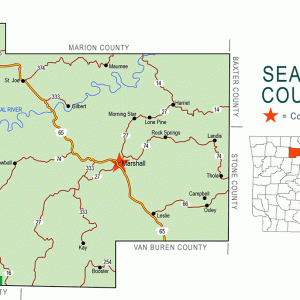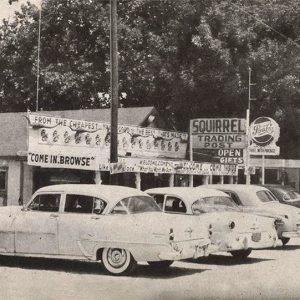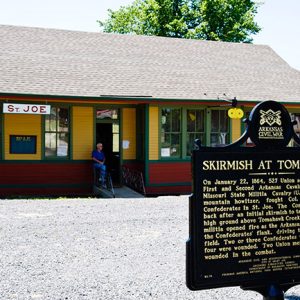calsfoundation@cals.org
St. Joe (Searcy County)
| Latitude and Longitude: | 36°01’48″N 092°48’17″W |
| Elevation: | 797 feet |
| Area: | 1.24 square miles (2020 Census) |
| Population: | 129 (2020 Census) |
| Incorporation Date: | July 11, 1904 |
Historical Population as per the U.S. Census:
|
1810 |
1820 |
1830 |
1840 |
1850 |
1860 |
1870 |
1880 |
1890 |
1900 |
|
– |
– |
– |
– |
– |
– |
– |
– |
– |
– |
|
1910 |
1920 |
1930 |
1940 |
1950 |
1960 |
1970 |
1980 |
1990 |
2000 |
|
159 |
181 |
255 |
213 |
187 |
– |
– |
– |
– |
85 |
|
2010 |
2020 |
|
|
|
|
|
|
|
|
|
132 |
129 |
|
|
|
|
|
|
|
|
St. Joe is a town in northwestern Searcy County, located on U.S. Highway 65. Like many similar communities in Arkansas, St. Joe has an Old Town that was settled before the arrival of the railroad and a New Town that was built nearer the railroad. During World War I, St. Joe was a shipping center for the region’s lead and zinc mines.
Osage were traveling from the north to hunt and fish in the rugged Boston Mountains of northern Arkansas when the region became part of the Louisiana Purchase in 1803. Eventually, treaties with the U.S. government moved the Osage farther west, and the land was opened for white settlement. The first settlers in the St. Joe vicinity were Bill Campbell, George Turner, Harry Love, Decatur Robinson (or Robertson), and Matt Tyson. Love was a captain in the Confederate army during the Civil War, but official records report that nearly his entire company, including Love, deserted to the Federal army during the war.
According to the town’s website, the first name of the settlement was Monkey Run. The settlement’s population grew after the war, with several families—including that of Benjamin Franklin Henley—coming from the north. A post office was established in 1877 and was given the name Saint Joe, reportedly because some of the settlers had come from St. Joseph, Missouri. An eighteen-square-foot log building was built for the first school. The building also served as a Methodist church and a Masonic lodge. Several stores were built in St. Joe, and a grist mill was also built. St. Joe was an active mining center before the end of the nineteenth century, but it required the service of a railroad for the town to begin to flourish.
The St. Louis and Northern Arkansas Railroad (after 1906 the Missouri and North Arkansas Railroad) had been built as far as Harrison (Boone County) by 1901. In 1903, an extension was constructed across Searcy County; by 1909, the line extended to the Mississippi River in Helena (Phillips County). The railroad missed the settlement of St. Joe by more than a mile, resulting in new construction closer to the rails.
New Town rapidly surpassed Old Town in population and activity. The Methodist congregation built a church building in New Town. St. Joe became a shipping center for lead and zinc, and it also had several sawmills and lime kilns. The town was incorporated in 1904, and had a population of 159 by the next census. A bank opened in St. Joe in 1913, the same year that the Henley Hotel opened its doors to the public. The town also had four stores, a blacksmith, and a café.
A tornado destroyed much of St. Joe in 1917, including the Methodist church; the congregation again used the school for services for the next fifteen years. After World War I ended, the demand for lead and zinc plummeted, and residents of St. Joe had to find other sources of income. The Lime & Crushed Rock Company provided some jobs, and the town continued to serve as an outlet for cotton, cattle, timber, and produce. The Depression further damaged the local economy, and the bank closed in 1933.
Even during the Depression, St. Joe had some success. The Methodist congregation began building a new church structure in 1932. By the end of the 1930s, U.S. Highway 65 had been paved through St. Joe, bringing travelers and tourists through the town. This new travel corridor was especially significant after the railroad ceased operation in 1946. Around the middle of the twentieth century, the school district of Pindall (Searcy County) was consolidated into the St. Joe School District.
Due to the decline in population, the incorporation of St. Joe was allowed to lapse. In the late 1990s, residents filed the necessary paperwork to renew the incorporation. In 2004, the St. Joe School District was consolidated into the Ozark Mountain School District, which continued to conduct classes in the school buildings in St. Joe. Using grant money and local donations, the citizens of St. Joe refurbished the railroad depot, creating a railroad museum called the Historic St. Joe Depot. The building is on the National Register of Historic Places, as are the Henley Hotel and the Benjamin Franklin Henley House. Early in the morning of February 22, 2016, a fire destroyed St. Joe Mercantile, a building constructed in 1924.
For additional information:
Bowden, Bill. “Old Store Gone, Only Memories Left.” Arkansas Democract-Gazette, February 28, 2016, pp. 1A, 12A.
Handley, Lawrence R. “Settlement Across Northern Arkansas as Influenced by the Missouri & North Arkansas Railroad.” Arkansas Historical Quarterly 33 (Winter 1974): 273–292.
McInturff, Orville J. Searcy County, My Dear. Marshall, AR: Marshall Mountain Wave, 1963.
Pitcaithley, Dwight. “Zinc and Lead Mining along the Buffalo River.” Arkansas Historical Quarterly 37 (Winter 1978): 293–305.
Searcy County Retired Teachers Association. Searcy County Arkansas. Marshall, AR: Searcy County Retired Teachers Association, 1987.
St. Joe, Arkansas. http://www.stjoearkansas.org/index.html (accessed September 27, 2022).
Steven Teske
Butler Center for Arkansas Studies
 Limestone Quarry
Limestone Quarry  Searcy County Map
Searcy County Map  The Squirrel
The Squirrel  St. Joe Depot
St. Joe Depot  St. Joe Depot
St. Joe Depot 




Comments
No comments on this entry yet.